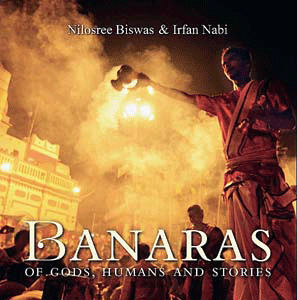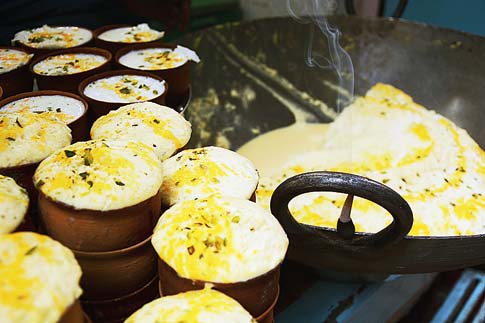It all started from a childhood fascination with Satyajit Ray’s Joy Baba Felunath where he brings alive the city of Benaras, to develop into a gorgeous book by author Nilosree Biswas with photographs by Irfan Nabi. Titled Banaras: Of Gods, Humans and Stories (Niyogi Books; Rs 1,750), this hardcover is a penetrative look into the character of a place that lend different meanings to people’s lives.

Irfan Nabi
“I sense that the everyday life of Benaras as portrayed by Ray had deeply attracted me; those free-flowing lanes, the crowded bazaars, the ghats, the old confectioners... Interestingly, when I made my first trip specifically for this book, I made sure to track Ram Bhander (the generational confectioners whom Ray had featured in the film). The unobstructed-ness of a Benarasi life drew me in,” said Biswas about inspiration for the book that managed to earn an appreciative nod from author Amitav Ghosh.
“Banaras therefore is a rebus of religious textual prescriptions, informed imagination, a state of mind both learnt and acquired, lots of antiquity, and much of commonplace lived-in spaces,” writes Biswas on her chapter on the cartography and etymology of Benaras.

Irfan Nabi. Irfan Nabi
Nothing could perhaps better describe the book than the potpourri of emotions that constitute the founding factors of Benaras that is upheld so beautifully through the juxtaposition of fluidic texts and pictures that come alive on the glossy pages. Replete with historical accounts, music, mourning and life, Banaras is a treat for all senses and to be able to capture it through words and images was no easy task.
Biswas, who is an author and film-maker from Jadavpur University, has previously joined hands with Nabi whose photographs have been a part of major exhibitions in Amsterdam, Washington, Calcutta and New Delhi to name a few, to create a book on Kashmir called Alluring Kashmir: The Inner Spirit. Just like their previous book, this one too is a billet-doux for a place that is alive with its own emotions, foils and fables. We spoke to the creators of the book to understand the creative process behind it. Excerpts…

“Fetching water from the Ganges, which is believed to be the holiest of rivers, has been a ritual practice since time immemorial, and it continues to this day”. Irfan Nabi
Nilosree Biswas
What was your research process like?
I am by training a documentary film-maker and therefore primary sources of research are vital for me. They include multiple recces, interviews, conversations with many leads. These are then topped with secondary materials, books, archival materials, office records of British government in India, trade records and travel accounts including diaries.
What were some of the more difficult choices you had to make as a writer while penning this book?
It was difficult not to include more historical understanding, which would then mean a research-heavy book, making it nearly academic. I did not want that to happen. I believe historical, cultural understanding about a city or its people must be written in an accessible, understandable way. Same with mythological inputs. So I had to balance these components. The idea was to reach out to a wider readership interested in culture, antiquity, mythology, history, people and their overlaps.

“A young artisan at work in a loom which weaves Banarasi Sarees”. Irfan Nabi
What is the collaborative process like?
It is a mix of individual perspectives, approaches that blend after a point. Irfan shoots as he perceives a subject and I research and collate, write the way I conceive the narrative. Then at the level of first draft of text and first edit of images, we engage further and materials go back and forth with remarks, comments and a finality is achieved. It is exactly how film editing is done.
How was writing about Benaras different from writing about Kashmir?
I have made more than one film on themes deeply connected to Kashmir, before I started working on Alluring Kashmir: The Inner Spirit. There was just a short gap between the films and the book and thus the book has benefitted from my familiarity with the place, the people. In fact, Alluring Kashmir was my distinct response to how Kashmir is lensed only via conflict. So I co-wrote a book that focused beyond conflict. Banaras was different. I have not yet directed a film on Benaras, which I would very much love to do. My understanding of Benaras is both more personal and historical research driven.

“Malayio, a unique winter drink made out of milk froth layered with juliennes of pistachios and a pinch of saffron — a heavenly temptation”. Irfan Nabi
What is your next project on?
The next project is on the European-colonial influences on Bengali cuisine. I take a deep focus into intersectional factors that have shaped the present day edible narrative of Calcutta.
Irfan Nabi…
Why Benaras?
I am drawn to places of antiquity and heritage. After having shot Kashmir and Ladakh extensively in the past few years, it was time to change the region and mood of the images.
I could sense that Benaras has an old soul of a storyteller, which the inhabitants have also imbibed. Rarely have I found people and everyday life so engaged and merged with history, faith, culture and traditions that it represents their identity and that of the city they belong to.
What are some striking observations that occurred to you while capturing Benaras, if any?
At a fleeting glance, the mornings, evenings or the happenings at the ghats of Benaras seem like a repeat of yesterday and this goes on and on. As one begins to focus and observe each passing moment minutely, the finer elements, the divine and the human connect appear. The thought that these very same rituals had been unceasingly practised since centuries and beyond, starts to sink in. This to me was the essence of Benaras and what draws the teeming millions.
What is your research and creative process like?
When I start a project, I shoot with a blank canvas. I consciously decide to see no reference work and instead of getting overwhelmed by the quantum of work that already exists on Benaras or any other subject, I build on my own perspective. Over multiple trips, across seasons, my language for the subject evolves. In Banaras, I mostly chose to be minimalistic in my frames while pushing the human elements and cultural stories to the forefront.
How would you differentiate between the experience of creating a book on Kashmir and a book on Benaras?
Most of my images have a human story and that connects with the ambience, intending to convey a sense of space. I don’t see this changing in my upcoming projects. The Kashmir book has a significant amount of landscape with inclusion of people, covering a vast region, hence travelling long distances through a conflict region came in to play. Benaras didn’t entail much travel and I could dedicate days to a specific location and sub-theme, which resulted in culturally nuanced images.
What can we expect next from your lens?
I intend to briefly dabble in food photography for a specific book written with food history as its seed idea. I am sensing an increasing desire to shoot Calcutta next, right now I am thinking of a hook point to weave the pitch around. A book on Ladakh, which has been due for publication for quite some time, should hopefully see a release.











